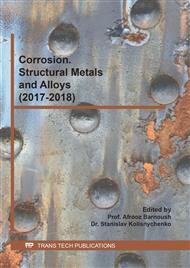p.228
p.233
p.239
p.244
p.249
p.254
p.259
p.264
p.270
Evaluation on the Mechanical and Corrosion Resistance of ALDC 12 Al Alloy by Three Types of Heat Treatments
Abstract:
Al is a active metal. However, it has a generally fine oxide film with thin and protective barrier, which is stable in air and neutral aqueous solution. Thus, Al alloys have been widely used in architectural trim, cold & hot-water storage vessels and piping. However, Al and most of their alloys may be easy to be corroded with various patterns of corrosion such as pitting, intergranular and galvanic corrosion etc. in the case of exposure to various industrial and marine corrosive environments. Therefore, an optimum evaluation of corrosion resistance for Al and Al alloys may be more important in a economical point of view. In this study, characteristics evaluation for ALDC 12 Al alloy by solution, normalizing, and aging (natural and artificial) heat treatments was carried out using electrochemical methods etc.. We can see that the hardness of ALDC 12 Al alloy were decreased by solution and aging heat treatments, in particular, the solution and natural aging (SNA) heat treatments indicated the lowest value of hardness. However, the lower hardness by heat treatment, the better corrosion resistance, for instance, the solution and natural aging (SNA) heat treatment exhibited the best corrosion resistance with showing the lowest hardness. Furthermore, the highest hardness was observed after normalizing and artificial aging (NAA) heat treatments. Therefore, it is considered that if improvement of the hardness as well as the corrosion resistance were to be required together, the normalizing and artificial aging (NAA) heat treatment should be performed. On the other hand, the solution and natural aging (SNA) heat treatment is thought to be an optimum heat treatment method for only corrosion resistance improvement.
Info:
Periodical:
Pages:
249-253
Citation:
Online since:
July 2017
Authors:
Price:
Сopyright:
© 2017 Trans Tech Publications Ltd. All Rights Reserved
Share:
Citation:



